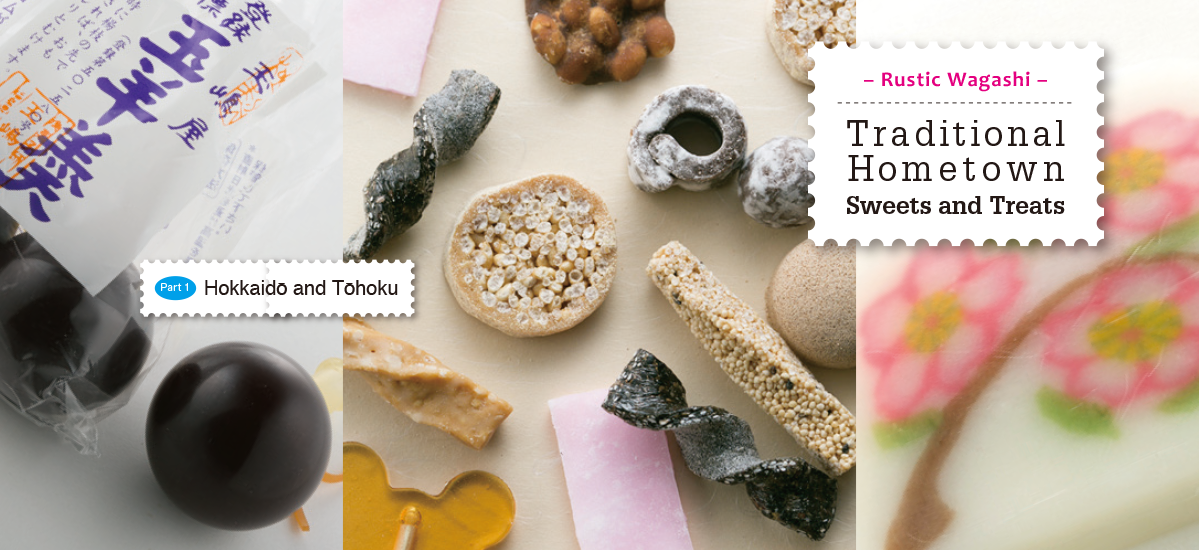
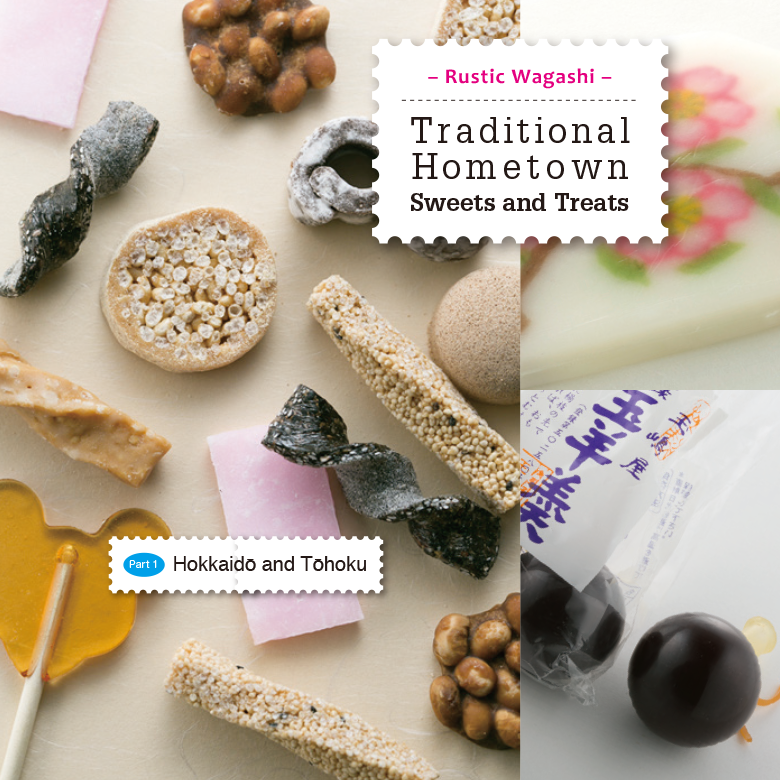
Wagashi are traditional Japanese confectionery, typically enjoyed on special occasions and popular as gifts. Each region of Japan boasts its own speciality sweets and snacks made locally for generations. These homestyle treats occupy a special place in the hearts of locals and make great omiyage for travellers looking for distinctive regional gifts to take home with them. Join us in exploring the old-fashioned sweets and snacks of rural and small-town Japan.
Text : 富山紀子 Noriko Tomiyama / English Version : Judy Evans
Keyword : Wagashi / Japanese Sweets / Fukushima Prefecture / Hokkaido / Yamagata Prefecture / Akita Prefecture / Aomori Prefecture / Iwate Prefecture
Northern Japan’s Distinctive Sweets
Grains such as rice, barley and buckwheat have always been precious ingredients in the snowy rural areas of northern Japan. The good folk of Japan’s northern provinces still use recipes handed down from their great-great-grandmothers to make sweet treats ready to serve visitors who brave the region’s snow-covered winter roads.
Hokkaidō – Gokatteya Marukan Yōkan

When the Gokatte-gumi, a group of logging families from the south, arrived in old Yezo Province to fell hinoki (cypress) in the early 1600s, they could hardly have suspected that their name would remain for posterity in association with one of the most distinctive sweets of southern Hokkaidō’s Esashi and Hakodate areas. As it turned out, the Gokatte-gumi were the first all those centuries ago to successfully grow beans in Hokkaidō, and beans are the main ingredient in Gokatteya Marukan Yōkan, a jellied sweet made from beans, agar and sugar.
This cylindrical treat is packaged in a unique cardboard tube that allows you to eat the yōkan straight from the pack – no sticky fingers! To get at the contents, you push up from the bottom and use the attached string to slice the yōkan.
The Gokatteya main store is located in the town of Esashi, but the products are available from a wide range of omiyagestores, restaurants and hotels throughout the Esashi and Hakodate area, as well as in other parts of Hokkaidō.
Address: Gokatteya Honpo (main store), 38 Honchō, Esashi, Hiyama-gun, Hokkaidō
Phone: 0139 52 0022 (in Japanese)
Aomori Prefecture – Beko-mochi

Fans of Japanese sweets will be familiar with mochi – soft, stretchy cakes made from pounded glutinous rice or rice flour – but Beko-mochi takes mochi to a whole new level. Introduced from Hokkaidō as a sweet for celebrating Tango no Sekku (Boys’ Day), Beko-mochi was originally two-tone brown and white, the colouring coming from brown and white sugar. It’s thought that the name “beko”, which means “cow” in the local dialect, may derive from this colouring. Local cooks on Aomori’s Shimokita Peninsula, the remote northeastern cape of Honshū, experimented with different colours and more intricate patterns, resulting in delightful floral designs that are revealed when the log of mochi is sliced. Various methods have been passed down through families, with each family having its own speciality. Look out for Beko-mochi at a wide range of supermarkets, omiyage shops and convenience stores throughout the Shimokita region.
This fascinating video shows homestyle Beko-mochi being prepared in the town of Ōhata, at the northern tip of the Shimokita Peninsula. https://www.youtube.com/watch?v=E_WohCpKpNI
Aomori and Iwate Prefectures: Kinka-mochi
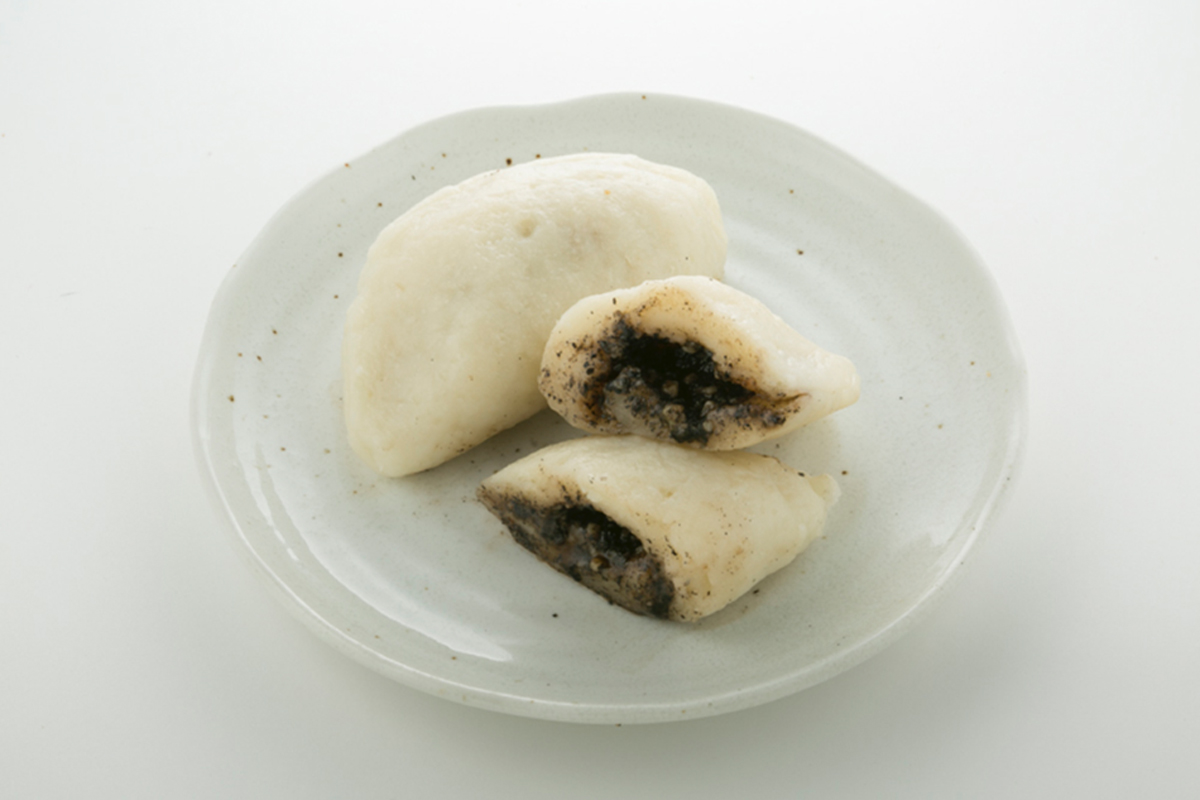
Kinka-mochi originated in the area around the Nanbu clan castle-town of Sannohe, on the Aomori-Iwate prefectural border. It was originally made as an offering to be placed on family altars during the summer O-bon festivities. Despite being called “mochi”, Kinka-mochi is actually made from wheat flour. This steamed dumpling contains a delicious sweet and salty filling made from walnuts, brown sugar, sesame and miso. The name “kinka”, which means gold or treasure, refers to the fact that the ingredients in the filling were once rare luxuries.
Kinka-mochi is available in Sannohe from Kinkadō, a little old confectionery shop a couple of streets west of Shiroyama Prefectural Park and the restored Sannohe Castle.
Address: Kinkadō, 70-1 Futsukamachi, Sannohe Town, Aomori Prefecture
Phone: 0179 22 2740 (in Japanese)
Akita Prefecture: Tofu Castella
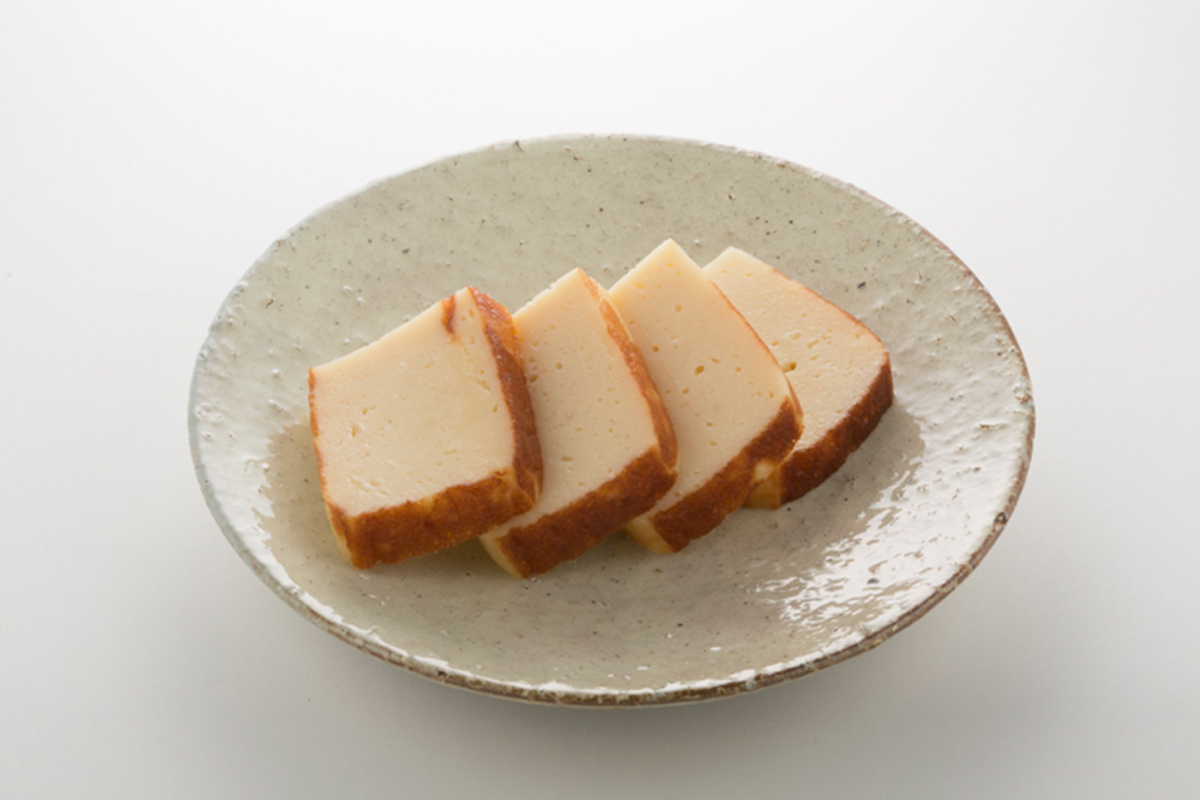
Tofu Castella is a traditional sweet from the southern part of Akita Prefecture. Sugar, eggs and salt are added to pressed and crumbled tofu, then mixed to a smooth custard before being cooked in long rectangular moulds over a hotplate. The soft, sweet treat is named for its resemblance to the Castella sponge cake introduced to Japan by Portuguese traders in the 16th century. One business renowned for their Tofu Castella is the one hundred-year-old wagashi maker Tsujiya, in the tiny Akita town of Daisen. Other specialities at Tsujiya include tofu kamaboko (pressed fishcake) and delicious, deep-fried ageman.
Address: Tsujiya, 1-20 Nakadōrimachi, Ōmagari, Daisen, Akita Prefecture
Phone: 0187-62-0494 (in Japanese)
Miyagi Prefecture: Sendai Dagashi
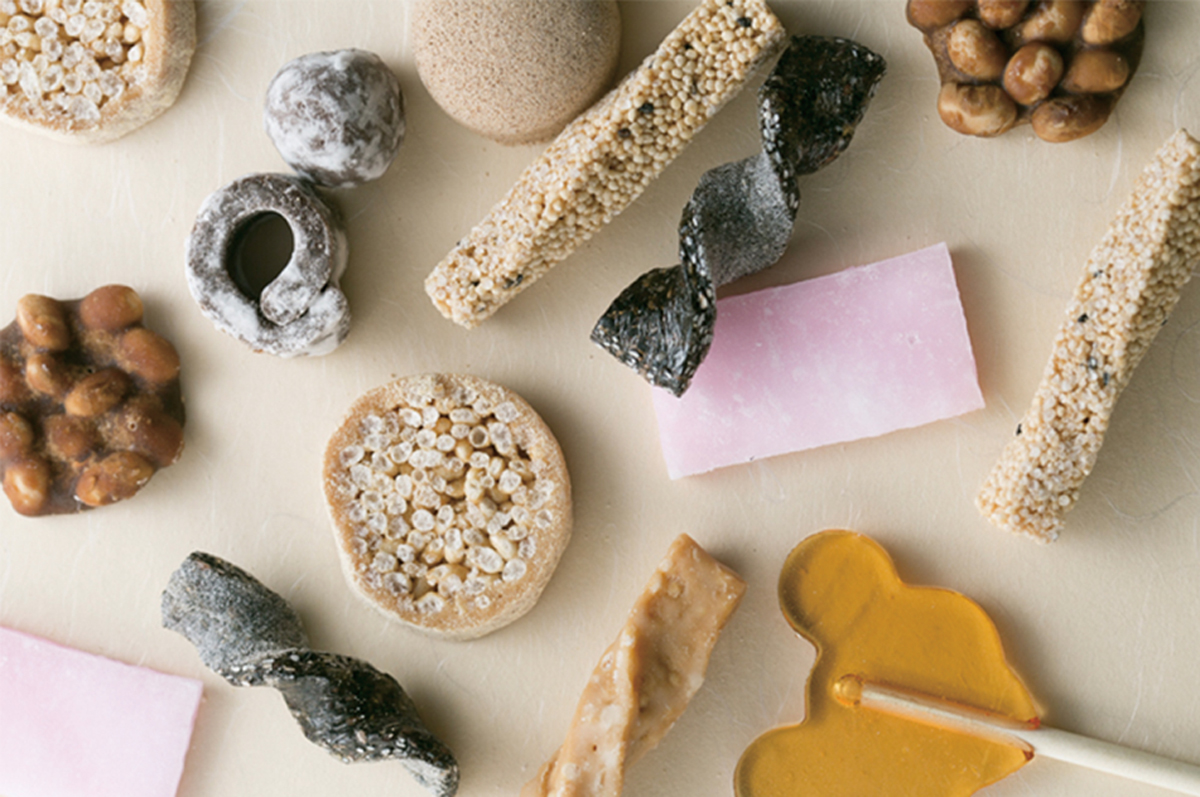
“Dagashi” are usually thought of as inexpensive, traditional snacks and candies aimed at elementary school children. However, dagashi from the former Date clan domain of Sendai have a tradition and flavour all of their own. The region was renowned in feudal times for the quality of its Sendai hoshi-ii, dried rice provisions supplied not only to Samurai troops, but also gifted as presentation items to the Shogunate government and the imperial court. When available locally, Sendai hoshi-ii was used to make unique confectionary. These days, Sendai Dagashi can be purchased at a variety of shops in the region, with bags of assorted sweet snacks bearing intriguing names such as kinako-nejiri (soy flour twists), goma-nejiri (sesame twists), usagi-tama(rabbit balls!) and gobō-kiri (burdock slice) being particularly popular.
Sendai Dagashi are available from Kumagaiya (Ganso Sendai Kumagaiya), a traditonal wagashi maker with a history dating back over 300 years.
Address: Kumagaiya (main store), 2-2-57 Kimachidōri, Aoba-ku, Sendai, Miyagi Prefecture.
Phone: 022 234 1807 (in Japanese)
Yamagata Prefecture: Kirisansho
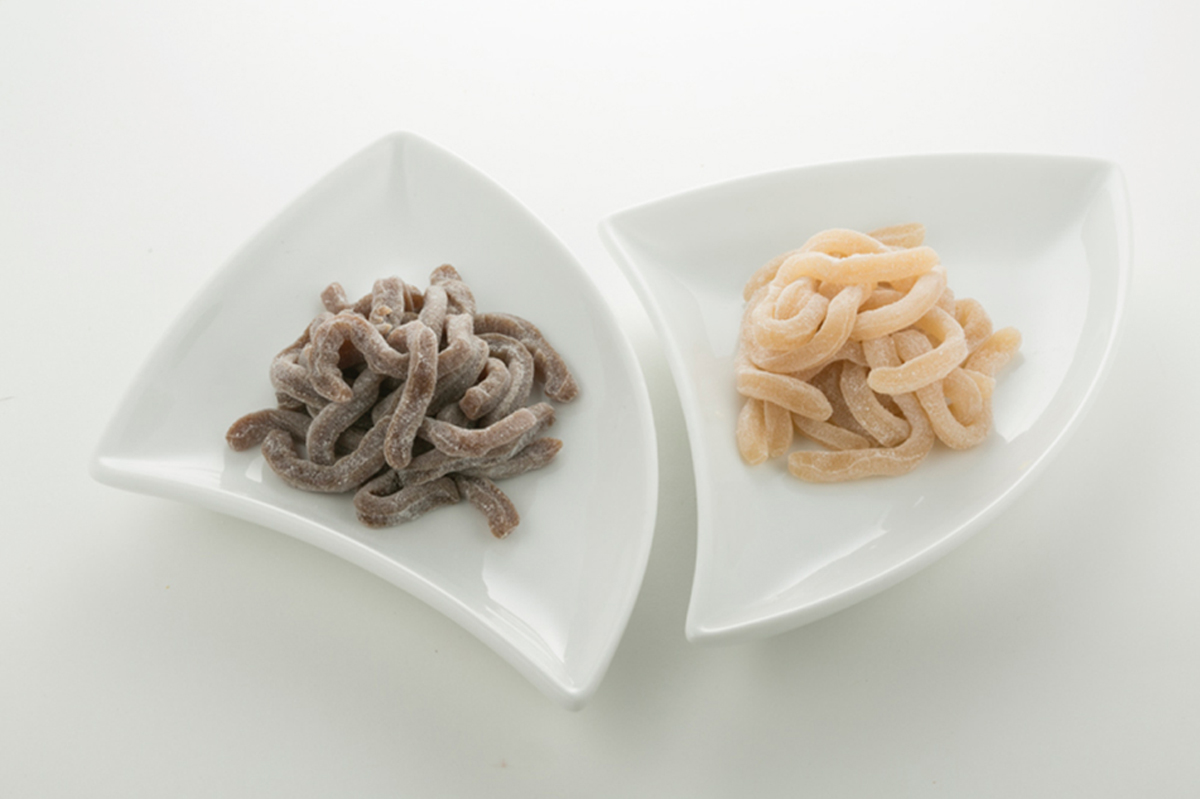
As the end of the year approaches in Tsuruoka City, Yamagata Prefecture, the local wagashi shops get busy making Kirisansho, a traditional confectionery eaten for good luck in the coming year. Preparation starts much earlier though, in about September, when the husks of dried sanshō (mountain pepper) berries are removed by hand and ground to a fine powder, a process taking several weeks. This powder is kneaded into mochi dough, then rolled out and cut into thick ‘noodles’. Kirisansho is made in two colours, brown or white depending on the sugar used, and the sanshō imparts unique spicy citrus notes to the flavour. Kirisansho is a seasonal treat, available in November and December, and typically found at the Daruma market held in the grounds of Tsuruoka’s Kannon-do Temple in the Nanukamachi area. Kirisansho is also sold at Kimuraya a venerable wagashi store and bakery with a very distinguished-looking old-fashioned concrete shop facade in Tsuruoka’s Sannō Dōri.
Address: Kimuraya, 9-25 Sannōmachi, Tsuruoka, Yamagata
Phone: 0235 22 4530 (in Japanese)
Fukushima Prefecture: Tama-yōkan

Nihonmatsu City in Fukushima Prefecture is famous for its Tama-yōkan, or sweet bean jelly balls, which were originally developed in the 1930s as provisions for troops on the battlefield. Encased in soft rubber balloons to keep them fresh, Tama-yōkan are not only delicious, they’re also fun to eat! Hold the bean jelly ball at the end where it’s tied and pierce the other end with a toothpick. The skin retracts instantly, leaving the Tama-yōkan on the end of your toothpick. Tama-yōkan are popular omiyage gifts to take home after visiting Fukushima Prefecture and are available at a range of stores, including Tamashimaya, whose main store is housed in a charming traditional wooden building about 250 metres from Nihonmatsu Station.
Address: Tamashimaya (main store), 1-88 Motomachi, Nihonmatsu City, Fukushima Prefecture
Phone: 0243 23 2121 (in Japanese)








